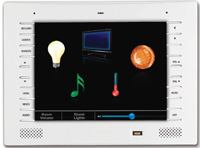With a home control system, electronics installers can make climate control part of an overall mode for an occupied or unoccupied home. “We can put the house into an Away setting for climate control,” says Evan Marty, senior programmer for Paragon Technology Group in Aspen, Colo. “If the client wants the temperature to be at 72 degrees every day when they’re in town, then when they’re out of town we can program the heat set point to 55 and the cool set point to 85. There’s no reason to keep the house that comfortable when no one’s there, and that has a huge effect on energy savings.”
Also as part of an Away mode, Marty programs the system to shut down every non-essential device that can affect the electrical meter. “We’re going to turn off lights and all the audio and video in the house so there’s no power consumption,” Marty says. “That includes always-on devices like amplifiers, stereo receivers, and cooling fans that trickle power even when they’re not in use.”
Marty has also been working with irrigation controls to manage household water use. One of his clients learned he had water rights to the river bordering his house so he put in an AccuWater system that uses free gray water from the river for landscaping and toilets, saving money on city-supplied treated water. Marty tied in the irrigation system to a weather system over the home network and the two communicate with each other. “If there’s been enough precipitation, the irrigation system doesn’t come on,” Marty says.
Lighting Control. The most popular form of energy control is lighting. Systems from Lutron, LiteTouch, Vantage/Legrand, CentraLite, Control4, and others offer energy management in various ways. Dimming, for instance, saves energy by reducing the amount of power required to light a bulb. It also helps sustainability by extending the life of bulbs and reducing the effects on landfills.
Lutron’s new Grafik EyeQ system controls shades as well as lights and features an input for an occupancy sensor which automatically turns off lights when no one has been in a room for a specified amount of time. Lutron’s electronic shades can be connected to an astronomical clock which automatically opens shades in the winter to take advantage of thermal heat gain and shuts them in the summer to help keep the house cool and reduce the strain on the air conditioning system.
The material used in shades can help with energy costs as well. Dark shades absorb more energy and light shades provide maximum reflectivity. In addition, Lutron offers a line of shades that are PVC-free, a popular sustainable fabric choice among architects and designers.
The LiteTouch Daylight Harvesting Keypad is another energy-saver. A sensor in the keypad monitors the amount of daylight coming into a room and adds only the amount of artificial light necessary to reach a desired level. The keypad also automatically dims artificial light in response to changes in natural light.
Not only is lighting control sustainable, says Philips of Cherokee Investment. “It helps achieve that wow factor that builders are looking for.” Green building, smart house control, and energy efficiency go hand in hand and help builders differentiate themselves. “Especially in a down market, we find that builders engaging in green building have more activity and are able to sell products faster than those who are not.”—Rebecca Day specializes in writing about home electronics. She can be reached at customhomerd@aol.com.



